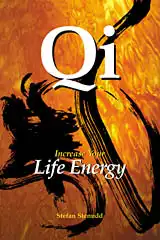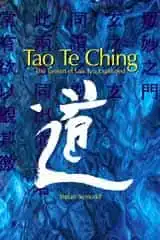|
Tao Te Ching
THE TAOISM OF LAO TZU
|
Tao Te Ching
|
The Book
The Taoism of Lao Tzu Explained. The great Taoist philosophy classic by Lao Tzu translated, and each of the 81 chapters extensively commented. Click the image to see the book at Amazon (paid link). |
It's All Real
Lao Tzu begins his writing about Tao, the Way, by stating that the written word cannot fully encompass the real thing. The workings of the Way are hidden behind what we can observe. It was present at the dawn of time and the birth of the universe, but it's visible only through what has been created out of it, in accordance with it: the whole world and all its creatures. Tao is the Way the universe works.
But that also means it can be understood by observing what can be observed: the manifestations. When we indulge in the world as we perceive it, we might be blinded by the splendor and magnitude of it all, but we do witness the workings of the Way, which is the principle behind it. We don't see the interior, but the surface. Still, its shape reveals a lot about what it covers.
If we want to see beneath the surface, into what really makes up the world, we have to detach ourselves from the attraction of that surface. When we distance ourselves from the world as if we are not at all part of it, then we can see through it. The mystery of its true nature becomes evident.
This is like an echo of Buddhism, although preceding it. Truth is revealed to the one who detaches himself from the world, not tempted by anything in it and not distracted by any of its phenomena.
Because we allow ourselves to be consumed by the world, we can't see it clearly. If we cease to look at the world for what we hope or fear that it will be to us, then we can see what it really is – its true nature, which is the Way.
But we don't have to see through the world to manage living in it. The manifestation is an expression of the Way, so it's as real and essential as the Way itself. Like the two sides of a coin. The world can be understood from its surface as well as from its interior. The descriptive words will differ, but the world and its workings remain the same.
The surface is just as real as what lies beneath it. They reveal one another. None exists without the other, so none is superior or inferior.
Opposites
We tend to think in opposites – light or dark, high or low, hot or cold, and so on. That's fine as a method of getting acquainted with the world and beginning to understand how it works. But when we make judgments, calling one opposite good and the other bad, we are mistaken. They complement and depend on each other. Even when one of them seems obviously superior, neglecting the other is unwise.Many belief systems praise the spirit and condemn the body, but the latter is the vessel of the former. They depend on each other. A spirit without a body cannot act, nor can a body without spirit. The Taoist treats each according to its nature. Both of them need concern and nourishment. Whichever one is neglected, both will suffer.
The unity of surface and interior also tells us that we should not make them contradict. If you pretend to be something that you are not, then your outside and inside are in conflict. Somewhere along the way you will break. They don't need to be exactly the same. They cannot, since they differ in nature. But they are companions on one and the same path. A human being is a whole, walking one way. If this whole is divided, for whatever reason, you will halt. You get nowhere.
When we accept that the mystery and the manifestations mirror each other, the secret is revealed. We can understand all. What you see is what you get, but you have to truly see it for what it is.
The manifestations become clear when you observe them with delight. The mystery appears when you detach yourself from the world and empty your mind. You will discover their unity: something and nothing embrace, and become all.
NEXT
Tao Te Ching Explained
Preface
Introduction
Literature
translated and explained by Stefan Stenudd.
1 |
2 |
3 |
4 |
5 |
6 |
7 |
8 |
9 |
10 |
11 |
12 |
13 |
14 |
15 |
16 |
17 |
18 |
19 |
20 |
21 |
22 |
23 |
24 |
25 |
26 |
27 |
28 |
29 |
30 |
31 |
32 |
33 |
34 |
35 |
36 |
37 |
38 |
39 |
40 |
41 |
42 |
43 |
44 |
45 |
46 |
47 |
48 |
49 |
50 |
51 |
52 |
53 |
54 |
55 |
56 |
57 |
58 |
59 |
60 |
61 |
62 |
63 |
64 |
65 |
66 |
67 |
68 |
69 |
70 |
71 |
72 |
73 |
74 |
75 |
76 |
77 |
78 |
79 |
80 |
81 |
Tao Te Ching Explained
James Legge's Tao Te Ching
Aleister Crowley's Tao Te Ching
The 1st Chapter of Tao Te Ching in 76 Versions
Lao Tzu — Legendary Author of Tao Te Ching
My Taoism BooksClick the image to see the book at Amazon (paid link).
The Taoism of Lao Tzu Explained. The great Taoist philosophy classic by Lao Tzu translated, and each of the 81 chapters extensively commented. |
About Cookies
My Other Websites:
I Ching Online
The 64 hexagrams of the Chinese classic I Ching and what they mean in divination. Try it online for free.
Qi Energy Exercises
The ancient Chinese life energy qi (chi) explained, with simple instructions on how to exercise it.
Life Energy
The many ancient and modern life force beliefs all over the world explained and compared.
Taoismen på svenska
Other Books by Stefan Stenudd
Click the image to see the book at Amazon (paid link).
 Cosmos of the Ancients
Cosmos of the Ancients
The Greek philosophers and what they thought about cosmology, myth, and the gods.
 Qi — Increase Your Life Energy
Qi — Increase Your Life Energy
The life energy qi (also chi or ki) explained, with exercises on how to awaken, increase and use it.
 Aikido Principles
Aikido Principles
Basic concepts of the peaceful martial art. Aikido principles, philosophy, and fundamental ideas.
 Life Energy Encyclopedia
Life Energy Encyclopedia
Qi, prana, spirit, ruach, pneuma, and many other life forces around the world explained and compared.
 Archetypes of Mythology
Archetypes of Mythology
Jungian theories on myth and religion examined, from Carl G. Jung to Jordan B. Peterson.
 Stefan Stenudd
Stefan Stenudd
About me
I'm a Swedish author and aikido instructor. In addition to fiction, I've written books about Taoism and other East Asian traditions. I'm also an historian of ideas, researching ancient thought and mythology. Click the image to get to my personal website.Contact

 Tao Te Ching
Tao Te Ching Tao Quotes
Tao Quotes Fake Lao Tzu Quotes
Fake Lao Tzu Quotes